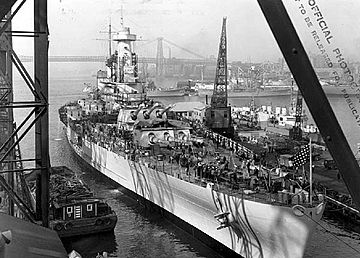Second London Naval Treaty facts for kids

The Second London Naval Treaty was an international treaty (an agreement between countries) signed in London, United Kingdom. This agreement came from a meeting called the Second London Naval Disarmament Conference. The conference began on 9 December 1935, and the treaty was signed by the countries involved on 25 March 1936.
Contents
What Was the Treaty About?
The treaty was signed by France, the United States, and most parts of the British Commonwealth. These included Australia, Canada, India, New Zealand, and the United Kingdom. Some parts of the British Commonwealth, like South Africa and the Irish Free State, did not sign. The Irish Free State did not sign because it had no navy.
Japan, which had signed an earlier treaty, left the conference on 15 January 1936. Italy also chose not to sign the treaty. This was mainly because other countries were upset about Italy's invasion of Abyssinia (now Ethiopia).
Limiting Warship Sizes
The main goal of the conference was to limit how many warships countries could build until 1942. However, because Japan, a major naval power, was not there, they could not agree on the total number of warships.
Instead, the treaty set limits on the maximum size of ships and the size of their guns.
- Battleships (called capital ships) were limited to a weight of 35,000 tons. Their guns could be no larger than 14 inches (356 mm).
- Submarines could not be larger than 2,000 tons. Their guns could be no bigger than 5.1 inches.
- Light cruisers were limited to 8,000 tons. Their guns could be 6.1 inches (155 mm) or smaller.
- Aircraft carriers were limited to 23,000 tons.
The "Escalator Clause"
The treaty included a special rule called the "escalator clause." This rule was added because the United States wanted it. It meant that if Japan or Italy still refused to sign the treaty after 1 April 1937, the countries that did sign (France, the UK, and the US) could increase the gun limit for battleships from 14 inches to 16 inches.
This clause was used in 1938. The treaty countries then agreed that battleships could be as large as 45,000 tons.
When the Treaty Ended
The Second London Naval Treaty effectively ended on 1 September 1939. This was when World War II began. Even before the war, some countries did not fully follow the rules.
For example, the United States built three types of battleships that were affected by this treaty:
- The North Carolina class was first designed for 14-inch guns. But after the "escalator clause" was used, they were finished with 16-inch guns.
- The South Dakota class was designed for 16-inch guns. They still kept the 35,000-ton limit.
- The Iowa class was designed starting in 1938. When the "escalator clause" was used, these ships were built with 16-inch guns and weighed 45,000 tons.
Rules for Submarines
The 1936 treaty also confirmed rules about submarine warfare from an earlier 1930 treaty. These rules said that submarines had to follow the same international law as surface ships. This meant that unarmed merchant ships (trading ships) could not be sunk without first making sure the crew and passengers were safe. Lifeboats were usually not considered a "place of safety."
More than 35 countries, including the U.S., Britain, Germany, and Japan, agreed to these submarine rules. This agreement was known as the London Submarine Protocol.
See also
- Washington Naval Treaty, an earlier treaty
- London Naval Treaty, another earlier treaty
- Anglo-German Naval Agreement

